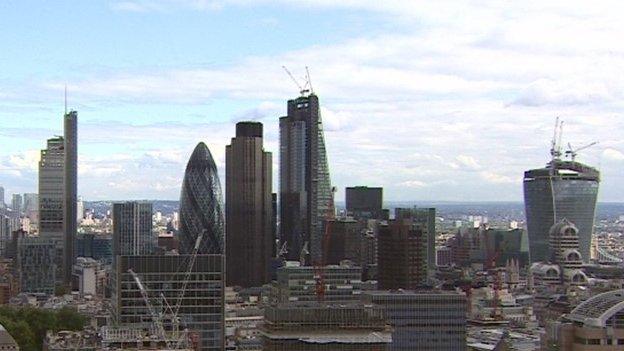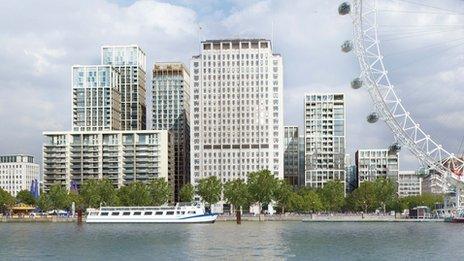London’s changing skyline: Are new skyscrapers good for the capital?
- Published

The "Walkie Talkie" (right) and "Cheesegrater"(centre-right) are the latest buildings to appear on the skyline
The "Walkie Talkie" and "Cheesegrater" are nicknames for just two of the latest bizarrely-shaped tower blocks to appear on London's skyline, to mixed reaction and sometimes unexpected consequences. The "Boomerang" and "Scalpel" are next in the pipeline. But are these modern-day monoliths good for the capital?
On an unseasonably hot September morning, Martin Lindsay parked his Jaguar on Eastcheap, in the City of London.
Two hours later, he returned to find parts of his car - including its wing mirror and badge - had melted.
It transpired the sun reflecting from the nearly-built 37-storey "Walkie Talkie" - nicknamed such because of its distinctive shape - was to blame.

A 60-storey residential skyscraper in Nine Elms, south-west London, has been approved
Within days, Eastcheap was not only under the full glare of the sun, but also the world's media - who were reporting smouldering bicycle seats, singed doormats and even eggs being fried on the street.
The "Walkie Talkie" was not the only skyscraper to unexpectedly hit the headlines this year.
Elsewhere, the observation deck on The Shard - western Europe's tallest building at 310m (1,016ft) - opened, while the Leadenhall Building, dubbed the "Cheesegrater", because of its distinctive wedge shape, became the second tallest building in the City of London at 224m (734ft).
But are these new additions to the skyline an improvement?
Architect and broadcaster Maxwell Hutchinson thinks so. "The change for the London skyline is a miraculous achievement in difficult economic conditions," he says. "London has become a showcase for tall buildings."
City of London chief planner Peter Rees, who has overseen its dramatic, vertical transformation since the 1980s, agrees: "Buildings like the Gherkin, Cheesegrater and Walkie Talkie are clear representations of how well London is doing.
"Clearly they are improvements to the skyline." But he warns: "We don't need to turn London into Manhattan."
Over the next year, the vertical evolution of London's skyline is set to continue.
In November, building began on US insurance firm WR Berkley's new European headquarters, labelled the "Scalpel".
But other approved schemes including the so-called "Can of Ham", and The Pinnacle, nicknamed the "Helter-Skelter", which was set to become the City of London's tallest building, have been put on hold.
In the case of the Pinnacle, developers went back to the drawing board to try to make the scheme more cost efficient.
Mr Hutchinson is optimistic about the next generation of towers. "The tall buildings in the pipeline will continue to progress London's commitment to achieving architectural world superiority," he says.
But Mr Rees says his personal view is that some skyscrapers are being built in unsuitable locations. "From Bermondsey to Battersea, you are confronted by isolated tall buildings and I believe this damages the city," he says.
"If you are building tall, you should cluster buildings together," he adds "It's no good building over each Underground station across London."
"I think we will end up with a very ugly looking place with random tall buildings."

In September, Communities Secretary Eric Pickles called in proposals to build a cluster of high rise buildings around the Shell Centre on the South Bank
Construction on south London Bankside's 50-storey One Blackfriars - dubbed the "Boomerang" - has already begun. But developers the Berkley Group would not release an image of the building for the purpose of this article.
Meanwhile plans for a 60-storey residential skyscraper in Nine Elms, south-west London, and further towers in Elephant & Castle and Waterloo have also been approved.
But earlier this year, advisers to the UN's heritage body Unesco said proposed towers at Waterloo, Nine Elms and Vauxhall should be revised, external because of their "negative impact" on views of world heritage sites Big Ben and Westminster Abbey.
Russell Gray, from the Bermondsey Village Action Group, which originally campaigned against The Shard being built, says: "The destruction of the skyline is a matter of huge regret. By the time people wake up to this it will be too late."

A 1954 conceptual high-rise scheme for Soho was designed by by Geoffrey Jellicoe
"The mayor has contributed enormously to this," he adds. "There has been a headlong dash for economic growth at any price."
A Mayor of London spokesman said: "What we can't do is try to impose some kind of freeze on the skyline and suspend the capital in stasis.
"The key issue in any discussion of London's skyline is whether a building makes a positive contribution to London's urban realm, protecting the things we value about our city, while helping us meet the challenges of growth and ensuring the continued prosperity of London and Londoners,"
In September, Communities Secretary Eric Pickles called in proposals to build a cluster of high rise buildings around the Shell Centre on the South Bank, describing them as a matter of "substantial controversy".
A new exhibition highlights how sometimes politicians do listen to the concerns raised over tall buildings.
Photos at English Heritage's London's Buildings Loved and Loathed exhibition, external shows how central London's Soho and Covent Garden might have changed beyond recognition.
But 1950s and 60s plans to replace the historic areas with giant tower blocks were later rejected.
- Published3 September 2013
- Published3 September 2013
- Published18 June 2013
- Published13 May 2013
- Published1 February 2013
- Published11 January 2013